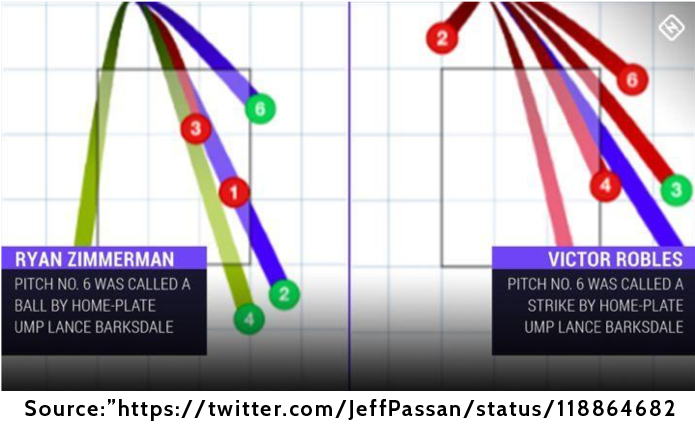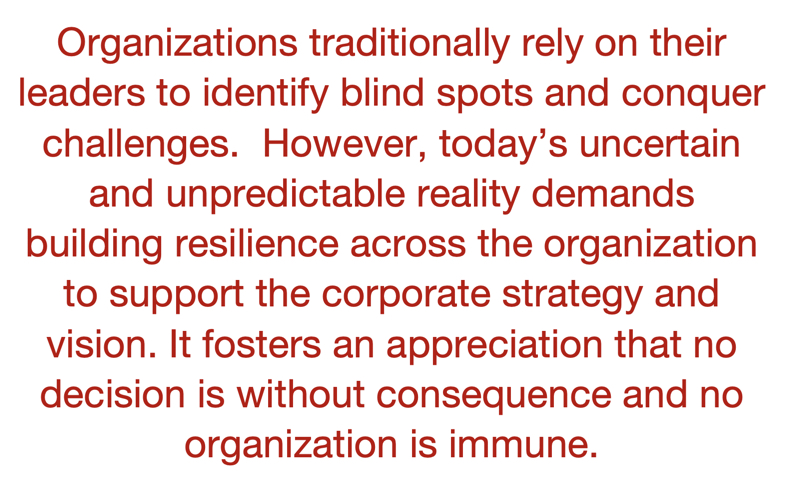Every Day is Game Day: Why Enterprise Resilience Matters

 For those of us who are Washington Nationals fans, 2019 was an extraordinary season. It even had a storybook ending – a World Series Championship that fans have anticipated since baseball returned to Washington, D.C. 14 years ago. The series had us out of our seats. It went seven games and for the first time in history, the road team always won.
For those of us who are Washington Nationals fans, 2019 was an extraordinary season. It even had a storybook ending – a World Series Championship that fans have anticipated since baseball returned to Washington, D.C. 14 years ago. The series had us out of our seats. It went seven games and for the first time in history, the road team always won.
If you read the Toffler Associates blogs regularly, you are familiar with our perspective on disruptive technology and resilience. While it might seem odd to draw a connection between these topics and the World Series, trust me, one exists.
Game Five, the Seventh Inning
In Nationals Park, plate umpire Lance Barksdale made the wrong call on consecutive batters. With two outs, Nationals first baseman Ryan Zimmerman was working a “quality at-bat” against Astros pitcher Gerrit Cole. With a 3-2 count, Cole unleashed a 92-mph slider that appeared to catch a high corner of the strike zone. Barksdale called ball four, and Zimmerman took first base.
 Nationals Center-Fielder Victor Robles was up. He worked the count full again. On the sixth pitch, he watched a 98-mph fastball fly outside the strike zone. Barksdale called it a strike.
Nationals Center-Fielder Victor Robles was up. He worked the count full again. On the sixth pitch, he watched a 98-mph fastball fly outside the strike zone. Barksdale called it a strike.
Both were bad calls. How do we know? Major League Baseball (MLB) uses software called TrackMan, a radar-based ball-tracking system that calibrates itself based on each batters’ size and stance. It adjusts the strike zone and synthesizes pitch data into binary outcomes – either a ball or a strike Anyone with access to the real-time images could see that the call was missed. From the dugout across social media, fans vented their frustration. In fact, my colleague was at that game, and said that as the crowd absorbed the bad calls, they started yelling at Barksdale. They opened their MLB and ESPN apps to watch the pitches real time and confirm their frustrations on Twitter’s Umpire Auditor. Confirming the calls turned into its own sport, fueled by a disruptive technology.
Would those missed calls have made a difference in the outcome of the game? No one knows. But here is something we do know: the missed calls raise a question about human bias. Given that we have TrackMan technology, why would we let bad calls happen?
Baseball and Bias
Any baseball fan knows that each umpire has tendencies and dictates his own strike zone and how he will call a game. Umpires are human, and their bias is part of the game. Software like TrackMan and PITCHf/x have served as a foil to highlight the (in)accuracy and (im)partiality of umpires. Whether we like it or not, bias is real.
Game officials do incredible work. Officiating is hard. There are dozens of arcane rules in the 188 pages of the 2019 Official Baseball Rule Book. Whether an umpire is on an MLB field or a dusty pick-up game, he or she is going to make a bad call now and then. Umpires have biases and distractions, and rarely is a call clear and obvious.
Perhaps that’s why growing evidence seems to favor Artificial Intelligence and robot umpires over their human counterparts. If software can track balls and strikes accurately and consistently, why opt for the alternative? Good is not enough when you can have better. When accuracy and consistency matter, anything less feels insufficient.
Game Six, the Seventh Inning
The Nationals went into game six down three games to two. The score was 3-2, and the Nats are leading at bat. With Gomes on first and no outs, Trea Turner hits a bloop to the left of the pitchers’ mound. Astros’ pitcher Brad Peacock fields the ball and guns it to first base.
Like a perfect storm, the ball, Turner, and first baseman Yuli Gurriel’s glove collide. Gurriel loses his glove and drops the ball. Gomes advances to third base and Turner heads to first. But home base umpire Sam Holbrook calls Turner out for interference, invoking an arcane rule. The problem is it was a bizarre interpretation of the rule and live television seemed to prove that Turner had run in a straight line and there was no interference. When the umps called the league office in New York for rule clarification, they came up short because the rules team could not be found.
And yet, the Nationals again demonstrated resilience. Their win probability dropped by 14.2 points after the call.[1] But we all know how game 6 ended. Anthony Rendon’s two-run homer put the Nats on top 5-2 in a game that would eventually be a 7-2 curly W for the Nats.
Perfect and Good
The whole situation shines a light on the organizational resilience of the MLB. We were reminded that no day (especially game day) is “business as usual.” Resilience means staying on our toes, anticipating that anything that could go wrong, likely will go wrong.
I am a fan of the adage, “do not let perfect be the enemy of good,” but in any high stakes endeavor (such as the World Series), good is not good enough. You need to be pretty close to perfect. The 2019 World Series play-by-play is a long but relevant wind up to this point — we need to build optimally resilient institutions.
In today’s dynamic risk environment, not being prepared for the unanticipated can constitute an existential threat. Having resilience means having pretty close to perfect preparation. The times demand nothing less.
 In thinking about resilience and disruption, Toffler Associates interviewed more than 30 organizations across the electric, financial services, communications, and hospitality industries. We asked each about the multi-dimensional impact of disruption, given the increasing interdependencies, availability of information, and impact of social media. These organizations acknowledged a need to get better at identifying blind spots and taking proactive steps to manage potential outcomes. They asserted that building a business resilience program doesn’t happen overnight. It requires commitment from stakeholders responsible for the integrity of the organization and the service of its customers.
In thinking about resilience and disruption, Toffler Associates interviewed more than 30 organizations across the electric, financial services, communications, and hospitality industries. We asked each about the multi-dimensional impact of disruption, given the increasing interdependencies, availability of information, and impact of social media. These organizations acknowledged a need to get better at identifying blind spots and taking proactive steps to manage potential outcomes. They asserted that building a business resilience program doesn’t happen overnight. It requires commitment from stakeholders responsible for the integrity of the organization and the service of its customers.
Through the course of these discussions, we identified eight leading practices common to organizations that have strong resilience structures in place.
Invest in a resilience program that is charged with expanding the risk lens, building capability and accountability, and balancing the focus between strategic and day-to-day priorities.
Resilient organizations require a dedicated and resourced program with leaders who can move beyond day-to-day operations to transform conversations about resilience into impactful decisions. A well-resourced program helps the organization imagine risks and, for each, their broad range of impacts and opportunities. The organization gains confidence around the knowledge that unplanned or unforeseen events and their consequences likely will happen, but the organization is prepared and can react.
Select a strong and vocal executive sponsor to own the resilience program and reinforce it with CEO and executive support.
Resilience must be an organizational priority that is set at the top. Meaningful CEO attention is vital. A program is more likely to thrive if it has focus, investment, and a respected executive champion with a proven history implementing programs.
Convene a dedicated, cross-functional group charged with achieving resilience objectives.
Resilient organizations recognize that every part of the business plays a role in its strength. Diversity of perspective exposes biases and blind spots. The cross-functional dialogue captures interdependencies and minimizes siloed decision-making.
Reinforce the behaviors required of all employees to identify and escalate potential resilience concerns, including the identification of specific risks and cascading impacts.
Resilient organizations acknowledge employees play a critical role in managing risk. They focus on ingraining resilience practices into how the organization operates, behaves, and decides. Employees are encouraged to question the status quo, imagine “what if,” and thoughtfully escalate concerns.
Develop a strategy for communicating and demonstrating how every employee directly contributes to the organization’s resilience.
Resilient organizations regularly invest in awareness and education efforts to drive understanding, reinforce desired behaviors, and promote continuous learning. They recognize the value of role-based education as well as individual awareness.
Design and execute stress tests, tabletop exercises, and scenarios that move beyond traditional operational responses to test the organization’s resilience posture.
Resilient organizations prioritize an agile response over a textbook response. Exercises and tests include employees from across the organization and explore reputational, regulatory, financial, operational, and strategic impacts. After action reports are completed, improvements are implemented, and quality is monitored.
Identify key stakeholders within the ecosystem and engage them in planning efforts and exercises.
Recognizing second- and third-order implications, resilient organizations engage key suppliers and vendors in resilience planning activities to enhance support and improve outcomes. Blue sky engagement and joint exercises hasten response and provide other mechanisms for identifying biases and blind spots.
Define resilience metrics, make space for evolution, and collect baseline measures. Emphasize accountability across functions by regularly measuring performance.
Resilient organizations recognize how metrics drive accountability but have found it difficult to quantify the true value of resilience. Reliability, availability, safety, security and other operational metrics and performance indicators are good baselines. Employee engagement and self-reporting are emerging measures, as is sharing outcomes from resilience-based decision-making.
The World Series showed us that disruption and the need for mature resilience behaviors impact sectors, industries, groups, and individuals across every conceivable space. We’re facing faster change, more connectivity, greater known and unknown threats, and bigger implications than ever before in history. Whether the outcomes are a pennant won or lost, the health of a business, or even the security of a civilization, we know that resilience measures are not optional. They require conscious, concerted efforts and leaders that have their eyes fixed on the outcomes. Let’s play ball.
November marks Infrastructure Security and Resilience month. Is it time to make your organization resilient?
[1] FanGraphs WPA Inquirer
- Categories
- Security and Resilience


 About the Authors
About the Authors